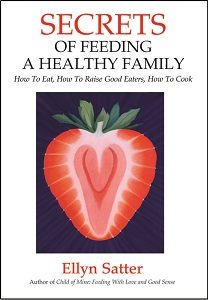

Family Meals Focus
The Ellyn Satter Institute Newsletter
COVID-19 has left even more hungry
by Ellyn Satter, Nutritionist and Family Therapist
For a PDF of this newsletter click here.
Currently over 2 in 5 mothers with children 12 and under say their food does not last and that they don’t have money to get more. That is up from 1 in 5 in 2018. One in 5 adult-only households report food scarcity.1 Part of the problem is that children are not getting food at school and child care, creating financial and food-security hardship for both children and providers. In better times, U.S. Department of Agriculture (USDA) National School Lunch Program, School Breakfast Program, and Child and Adult Care Food Program served nearly 35 million children daily. Children not in school or at child care miss out on food worth at least $30 per child per week. Local states and communities have set up direct food assistance, but it only serves a small part of the need.2
What can we do?
Give money and/or food to food banks and pantries. Volunteer. Bigger food banks get more out of your food dollar than you can by purchasing at wholesale prices and maintaining networks for rescuing food that would otherwise be wasted. While smaller, local, volunteer-run food banks may have a greater need for the food itself, many have stopped accepting food donations from the community to limit contact and slow the spread of COVID-19. Do your research and find out what they need most. Do what works for you and give what you can–every dollar helps.
Teach Eating Competence in food pantries. Lessons increase Eating Competence overall and particularly increase food context skills: Planning, providing, and eating meals.3 For parents, food insecurity is often about shame: feeling bad about not providing enough food or “healthy” food. To improve morale and build the meal habit, consider interactive classes based on the ESI curriculum, Mastering Meals Step-by-Step. Encourage beginners to “Eat what you eat now, just have it at regular meal-and snack-times.” Encourage savvy folks who already plan and prepare meals to share their savvy with others. Show in-between folks how they can make planning their servant, not their master.
Be political. Ask your legislator for more money to help low-income people buy food. Ask them to increase direct funding to families in the form of SNAP (Supplemental Nutrition Assistance Program AKA Food Stamps), WIC (Special Supplemental Nutrition Program for Women, Infants, and Children), and extending the Pandemic Emergency Benefits Transfer.
Approach nutrition education with the ecSatter-informed conviction that it is natural for people to learn and grow when their basic food needs are met.
Support practical food-management strategies
Even with the best management, there simply may not be enough money. These strategies may help a bit.
- Get rid of good-food-bad-food thinking. It makes others feel bad and makes it harder to feed a family. Instead, approach nutrition education with the ecSatter-informed conviction that it is natural for people to learn and grow when their basic food needs are met.
- Encourage meals and sit-down snacks. Meals give structure and give control of the food supply and therefore the budget. At meal- and snack-time, encourage providing, not depriving or avoiding.
- Consider higher-calorie forms of usual foods. Whole milk, canned peaches in heavy syrup, fried chicken, buttered or sauced vegetables, and fruit cobblers or pies are just as nutritious as their low-fat, low-sugar versions and are much more filling.
- Include high-fat foods at mealtime: butter or margarine, gravy, and regular salad dressing. Fat makes meals filling and long-lasting. Letting everyone eat as much as they want of fatty condiments satisfies the big appetites without overloading the small ones.
- Serve one each of any expensive foods, all-you-want-to-eat of others. Meat, poultry, and fish cost too much to fill up on. Starchy foods such as potatoes, rice and noodles, are less expensive.
- Stretch meat, poultry, and fish. Meat, poultry, or fish add flavor and nutrients to a stew, soup, or casserole. Add meat, poultry, or fish as a condiment to bean dishes.
- Choose foods that don’t spoil. Canned vegetables and fruit are just as nutritious as fresh (and maybe more). So are frozen, if you have the freezer space.
- Introduce new foods in small amounts. Encourage preparing just enough for each a taste.
- Teach children to take many small helpings. Because they don’t have experience with estimating how much they will eat, children naturally waste food. Minimize the waste by encouraging them to take as many small helpings as they want.
- Be deliberate about “forbidden” foods. Include sweets, chips, and even soda often enough at meal- and snack-time to take the “special” out of them.
You may fear that encouraging your audience to choose higher-fat, higher carbohydrate, and even “forbidden” food will make their diets unhealthy and fattening. Not so. Feeding themselves faithfully and giving themselves permission to eat as much as they want of food they enjoy supports Eating Competence. Eating Competent people have healthier diets, weigh less, have better blood lipids and blood sugars, and even sleep better!
References
- Bauer LA. The COVID-19 crisis has already left too many children hungry in America. Accessed November 23, 2020, 2020. https://www.brookings.edu/blog/up-front/2020/05/06/the-covid-19-crisis-has-already-left-too-many-children-hungry-in-america/
- Dunn CG, Kenney E, Fleischhacker SE, Bleich SN. Feeding Low-Income Children during the Covid-19 Pandemic. New England Journal of Medicine. 2020;382(18):e40. doi:10.1056/nejmp2005638
- Umoren J, Brasseur K, Yao P, et al. Food Pantries Integrating Eating Competence, Interest/Enjoyment in Physical Activity and Self-Efficacy for Pantry Participants. J Nutr Educ Behav. 2020;52( ):195-198. doi:10.1016/j.jneb.2019.10.003
Explore
Understand and Apply ecSatter
Ellyn Satter’s Secrets of Feeding a Healthy Family says the secret of raising a healthy eater is to love good food, enjoy eating, and share that love and enjoyment with your child. When the joy goes out of eating, nutrition suffers.
Treating the Dieting Casualty VISION Workshop
Are you looking for a way to help your clients normalize their relationship with food after years of dieting or disordered eating? This intensive workshop trains professionals in Satter’s How to Eat method. The method has been defined by Ellyn Satter in over 35 years of clinical practice.


